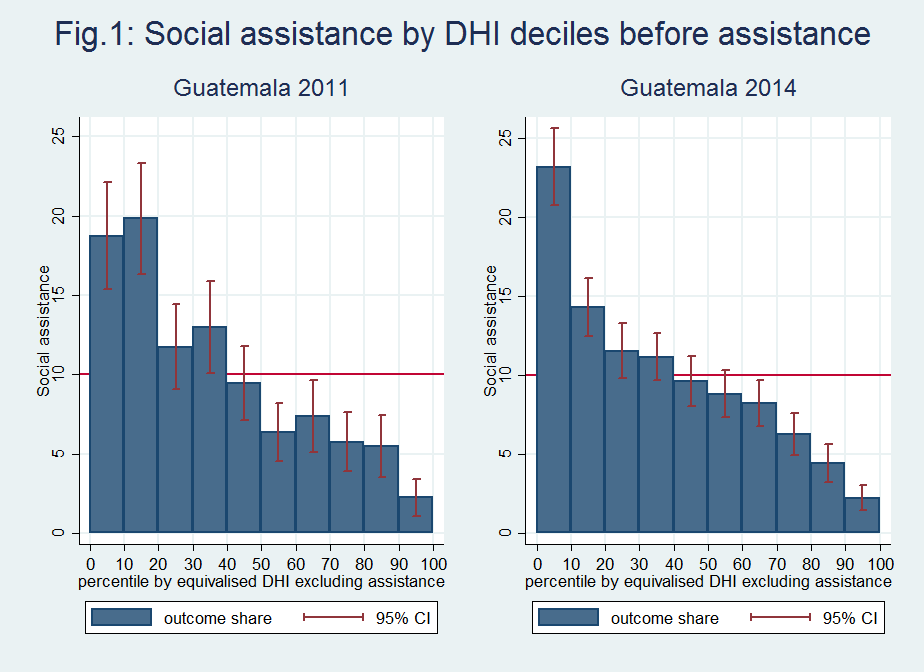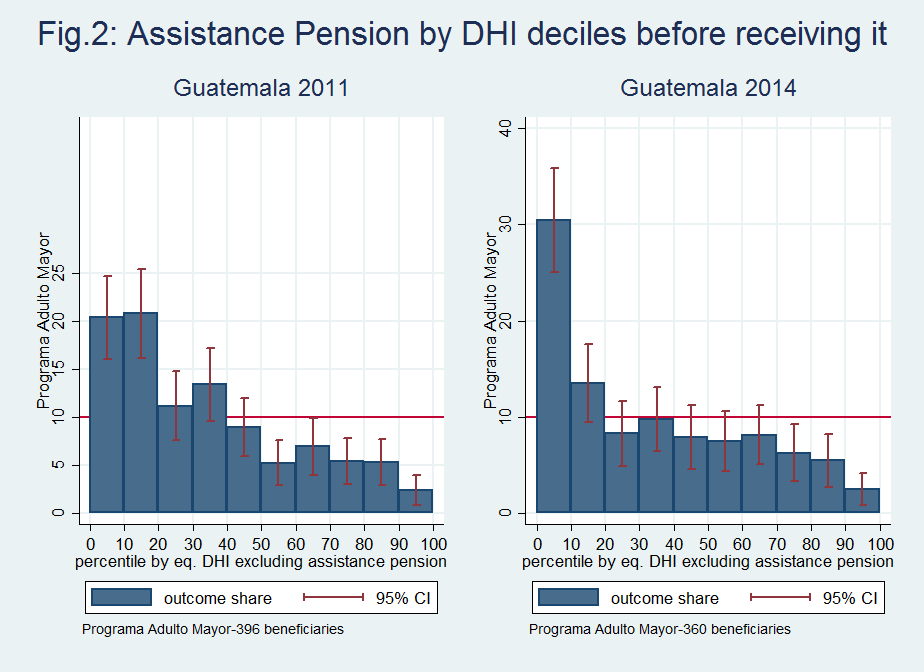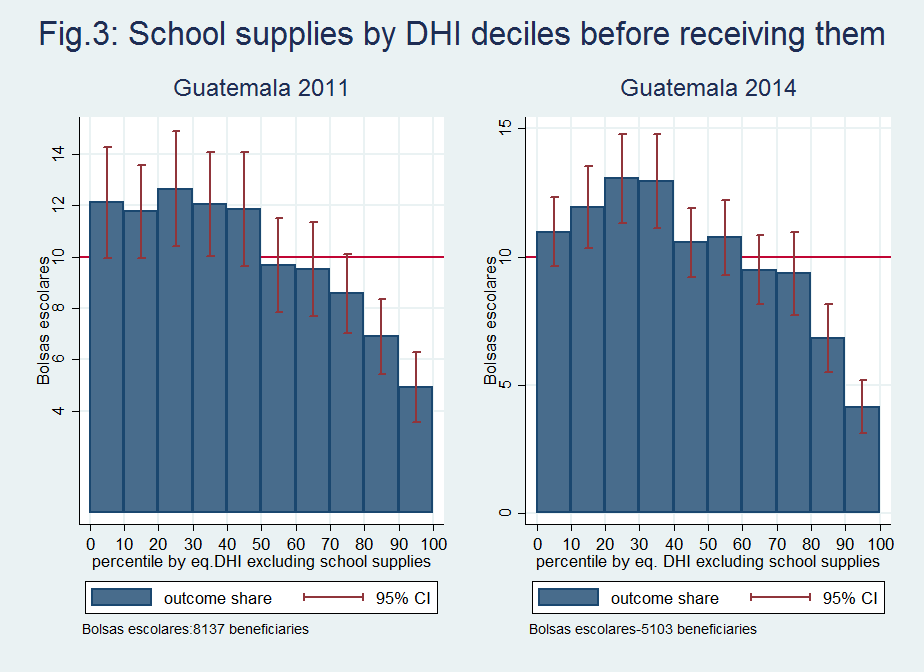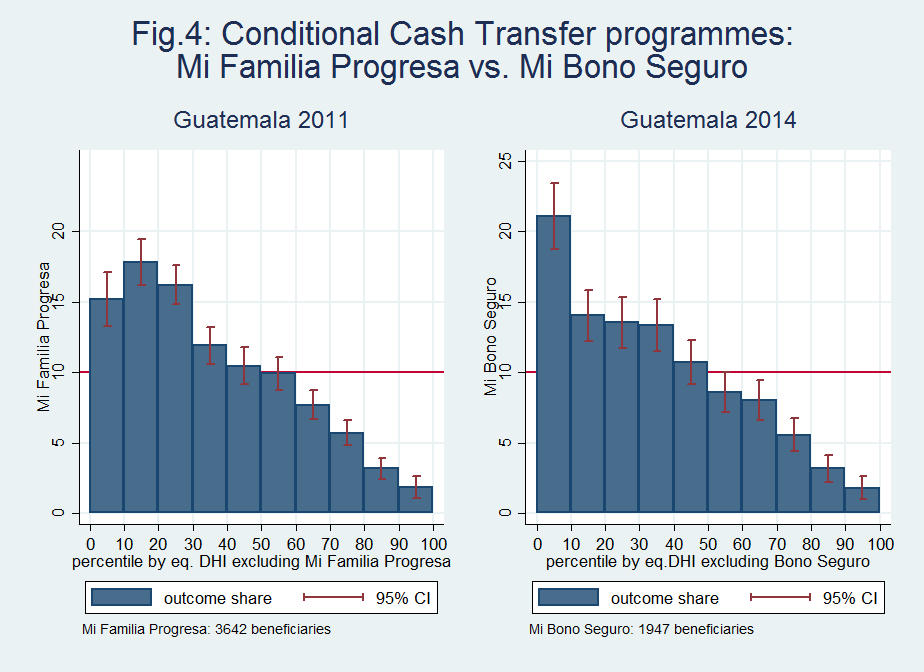Issue, No.2 (June 2017)
Guatemala 2011-2014: better targeting of assistance benefits?
Guatemala is known to be a country with large inequalities and high poverty. However, in the last years the country experienced a constant economic growth, with an average per year of 3.77 percentage points between 2011 and 2014 (Guatemala National Statistical Institute). For the same period there was a noticeable decrease in Gini coefficient from 0.481 in 2011 to 0.437 in 2014. Overall, relative poverty rate (50% of the median) decreased by more than three percentage points to 19.5% in 2014, decreases in the poverty rates were most substantial for children from 27% to 23%, while the poverty rates for elderly only slightly decreased by less than 1 percentage point, reaching almost 24% in 20141.
One of the possible causes of decreasing poverty could be that the social benefits are better targeted to the poor. A World Bank Report (2009) was stressing that “overall social protection programs are barely pro-poor with more than half of the benefits going to the second and third quintiles…neither in-kind nor cash transfers are pro-extreme poor”. These conclusions were based on 2006 data from ENCOVI, the Guatemalan Survey on Living Conditions. Using the two new datasets from the same survey for 2011 and 2014 that were added recently to the LIS Database, we want to see if the targeting of the assistance benefits towards the poor and especially those in extreme poverty improved over time.
Looking at the overall picture, we observe from Fig. 1 an increase of 4.5 percentage points in the social assistance given to those in extreme poverty (in the first income decile calculated by equivalised2 disposable household income before social assistance transfers) up to 23.2% of total social assistance in 2014. Nevertheless, only about 60% of assistance benefits goes to the first four income deciles, a decrease of 3 percentage points compared with 2011; while for the middle 4th-8th deciles we observed an increase in the receipt of social benefits of over 4 percentage points, with 33% of social benefits in 2014. Even the last two deciles are experiencing an increase in the receipt of social assistance, with 6.7% of the total social assistance in 2014, while the social assistance is not supposed to be targeted towards them.

Looking at few benefits in particular, the picture is more nuanced. In Fig. 2 we see that the assistance pension (Programa Adulto Major), that grants a social pension to the over 65 years old in need, improved substantially in targeting the poorest poor with an increase of over 10 percentage points for the first decile by disposable income prior to the social pension, reaching 30.5% in 2014. However, except the poorest poor, the targeting of the elderly assistance did not improve for the first four deciles; on the contrary, it decreased by 3.5 percentage points till it reached 62% in 2014. The difference was reflected in an increase of over 3 percentage points for the 5th-8th deciles, reaching almost 30%, together with a slight increase for the two upper income deciles, receiving almost 8% of social pension benefits in 2014. We note, nonetheless, the very low number of benefits granted.

One of the successful programmes mentioned in the World Bank Report is the School Supplies programme (“Bolsas Escolares”) that delivers school necessities to school age children in poor regions; the programme covered 12.9% of the population in 2006 (World Bank, 2009). Fig. 3 below shows that the coverage of the poorest poor decreased, reaching only a bit under 11% in 2014. The overall coverage for the first four deciles slightly increased, reaching almost 49% in 2014, the same being observed for the coverage of the 5th-8th deciles, while the coverage of the two upper deciles slightly decreased reaching about 11% in 2014. All these changes were under 1 percentage points, therefore the coverage was rather stable over time, consequently there was no significant progress observed in the targeting of this benefit between the two points in time, except between the first two deciles and the 3rd-4th deciles.

Guatemala also introduced conditional cash transfer programmes (CCT) in 2008. The first programme of this kind, “Mi Familia Progresa”, was conditional on school attendance of children aged 6 to 15 with an emphasis on nutritional aspects and was aimed to target households in extreme poverty with children and pregnant women living in disadvantaged areas. In reality only about 15% of benefits were received by those in extreme poverty in 2011, as we can see from Fig. 4.
In 2012 the programme was replaced by “Mi bono securo”, also a CCT programme conditioned on school attendance and doing regular health check-ups, which has the same target group as the previous programme. Did the newly introduced benefit target better the poor than the benefit that replaced it? It does seem to be the case, with over 21% of benefits received by the poorest poor, the data shows a substantial increase of almost 6 percentage points. However, overall, the proportion of benefits received by those in the first four deciles increased by less than 1 percentage points reaching 62% in 2014, a change reflected by a proportional decrease in the coverage of the middle deciles, with 33% of benefits in 2014. The coverage for the two upper income deciles remained stable overtime at about 5% of CCT benefits aimed only at people in poverty. This could be explained by the abuse and corruption in granting the benefits that was discovered and acknowledged by the Ministry of Social Development which, in the end of 2015, promised to improve the targeting of the CCT programmes.

Based on the comparison between the two waves we can conclude that, overall, social benefits are targeting better those in extreme poverty in 2014 than before. However, there is little change in the coverage of the first four deciles. In the same time, the middle and top deciles continued receiving a substantial share of the social assistance. Consequently, there is still a need to target better social assistance programmes to those in poverty (and not only those in extreme poverty) and especially to restrict the access to assistance benefits to those who are in the upper deciles of income distribution through a better implementation of the social assistance programmes.
1 own calculations based on LIS data.
2 disposable household income was equivalised dividing the total income by the root square of household members.
References
| Jann, B. (2016), “Assessing inequality using percentile shares”, The Stata Journal, Vol. 16 (2): pp. 264-300. |
| Guatemala Government: Ministerio de Dessarrolo Social, at: http://mides.gob.gt/mides-hace-efectivo-pago-de-bono-de-salud-y-educacion |
| Guatemala National Statistical Institute: https://www.ine.gob.gt |
| World Bank (2009), “Guatemala – Poverty assessment: good per-formance at low levels”, Report No. 43920, March 2009, available here |
